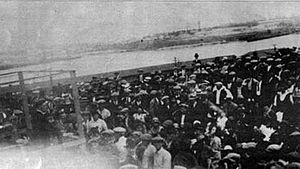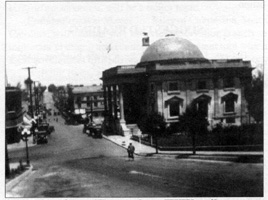1923 San Pedro maritime strike facts for kids
The 1923 San Pedro maritime strike (also known as the Liberty Hill strike) was a major event in Los Angeles, California. At the time, it was the biggest challenge to the idea of "open shops" in the city. An open shop is a workplace where workers do not have to join a union. This strike happened before the Congress of Industrial Organizations (CIO), a large group of unions, became powerful in the 1930s.
The strike was led by members of the Industrial Workers of the World (IWW), also known as the "Wobblies." They stopped ships from moving in the harbor. During the strike, famous author Upton Sinclair led a large protest on a small piece of land called Liberty Hill. He was arrested there for reading the First Amendment from the U.S. Constitution. The strike was eventually stopped by court orders, many arrests, and actions by police and the Ku Klux Klan. There wouldn't be another big waterfront strike like this until the 1934 West Coast waterfront strike.
What Led to the Strike?
Working conditions for sailors and dockworkers on the Pacific coast had been difficult for many years. Traditional unions for sailors and longshoremen (people who load and unload ships) struggled. They faced problems like disagreements within their own groups, strong opposition from newspapers like the Los Angeles Times, and powerful employer groups. These groups made it hard for unions to change the "open shop" system in Los Angeles.
Employers used a method called "decasualization" to fight against unions. This meant they controlled who got hired through special offices. They tried to keep out anyone who supported unions. Even with these efforts, members of the IWW were able to secretly join many docks on the West Coast by pretending to be part of other groups.
The IWW didn't have much success in California's ports until World War I. As America prepared for war, ports became very busy, and there weren't enough workers. In May 1916, the International Longshoremen’s Association started a strike in Seattle, Washington, asking for higher pay. About 1,600 dockworkers in San Pedro also went on strike. But the strike ended quickly when employers hired a special Los Angeles Police Department unit. This unit protected workers who crossed the picket lines, helping to keep the "open shop" system.
In October 1919, the San Pedro Chamber of Commerce announced it wanted to fully restore "open shop" conditions throughout the harbor. All local businesses supported this. This led to another small strike, which was also quickly broken. Local unions weren't strong enough to resist, and most union leaders gave up. However, the IWW members in town did not. The IWW's main office in Chicago asked all remaining Wobblies on the West Coast to go to San Pedro. They wanted to challenge the "open shop" system on the docks and fight against California's criminal syndicalism law, which made it illegal to promote certain ideas about changing society.
The IWW quickly became active. They caused disruptions, but employers weren't too bothered until the American Federation of Labor (AFL) union was removed. After that, IWW members became unwelcome. Still, efforts to keep Wobblies from working on the docks didn't fully succeed. Even with many IWW members arrested under the new criminal syndicalism law, there was still a lot of unrest on the San Pedro docks. In early 1923, there were several small strikes that caused delays for many ships.
The Strike Begins
The main strike began on April 25, 1923. This was soon after a grand jury in Los Angeles County looked into violations of the criminal syndicalism act. The San Pedro Local No. 510 of the IWW called for a strike, which effectively shut down the port for several days. The strike was happening across the country, with important points in New York and Los Angeles. About 5,000 workers went on strike on the East Coast, and probably 1,500 locally in San Pedro, with some estimates as high as 3,000. It didn't have much effect at other Western ports. However, some lumberjacks and oil workers joined, and another independent union, the International Transport Workers' Federation, supported the Wobblies. Members of the Sailors' Union of the Pacific did not support the strike. This was partly because the IWW started it, and partly because they were already doing a "slowdown" at work, which was having some success.
This strike was a mix of a regular strike for better pay and a political protest. Across the country, one of its goals was to free political prisoners. These were people accused of going against the government or held under California's criminal syndicalism law.
The strike stopped about ninety ships in the Port of Los Angeles. Police quickly began arresting known IWW leaders, which weakened the strike. This allowed some ships to start moving again. Twelve ships involved in overseas trade, whose crews supported the IWW, faced the longest delays. Many of the thirty-seven lumber ships in port had non-union workers or members of the Sailors Union. Still, their cargo had to be unloaded by ship officers because there weren't enough dockworkers.
Then, the Wobblies used their newspaper, the Industrial Worker, to call for a citywide strike on May 1, 1923. This date is known as May Day, a historic day for workers around the world. They called for the strike to "free the class prisoners," which was the IWW's term for those jailed under the criminal syndicalism act. On the same day, IWW leaders convinced about 450 out of 2,200 workers to strike at refinery construction jobs near the harbor. It looked like the strike might spread beyond the waterfront. So, employers decided to act quickly to prevent this and move ships faster.
However, talks with the longshoremen failed. The workers demanded their own hiring hall and wanted to get rid of the "Sea Service Bureau," or "Fink Hall," which was controlled by the shipping companies. About 1,200 longshoremen voted to stay on strike until employers met this basic request.
The Los Angeles Police Department sent about 140 extra police officers and 20 detectives to the docks to keep order. On May 5, more than 100 strikebreakers arrived and immediately started working. Two hundred more were planned for May 8, and another 750 a few days later. By May 10, 1,500 longshoremen were working, and 350 of them were imported strikebreakers. The extra police force grew to 250, partly because of a fire on May 5 that was clearly set on purpose.
As the strike entered its fourth week, the police became even tougher on the Wobblies. The Los Angeles office of the KKK handed out flyers to local citizens, asking for support to help the police break the strike. Members of the Ku Klux Klan, sometimes with their hoods and sometimes without, regularly came to the San Pedro docks to scare people. The IWW and their supporters started to see the conflict as a fight for free speech. They continued to hold meetings near the waterfront at a place called Liberty Hill. This was private land, and the owner had given them permission to use it. Local supporters and members of the American Civil Liberties Union joined IWW leaders to protect free speech rights. Famous people from Los Angeles and Pasadena, like Upton Sinclair, were among them.
In the evening of May 15, 1923, Upton Sinclair stood before a crowd on Liberty Hill in San Pedro. He wanted to honor the hill's name by using words to test the limits of freedom and protest. He began to speak, "Congress shall make no law respecting an establishment of religion, or prohibiting the free exercise thereof; or abridging the freedom of speech . . ." Before Sinclair could finish reading the First Amendment, he and three others were arrested. The officer who arrested him was heard saying, "We’ll have none of that Constitution stuff." Three days later, seventy-one people believed to be IWW members were arrested and jailed. Police actions against strike leaders were so effective that the Shipowners' Association declared the strike over on May 18. On that day, 2,800 longshoremen loaded or unloaded eighty-five vessels, making it the busiest day in the port's history. Fifty police officers immediately returned to Los Angeles for regular duty, and 500 strikebreakers were given permanent jobs.
Even though the strike was losing ground, IWW leaders didn't give up. Many of their members were in jail, and others had left town to find jobs elsewhere. The efficiency of dock operations improved every day. Strikers who were not proven Wobblies began returning to work through the "open-shop" Sea Service Bureau. But the strike still continued. On May 21, 3,000 posters announced a meeting at Liberty Hall in San Pedro for the evening of May 23. Upton Sinclair and other speakers were scheduled to address the meeting, organized by the American Civil Liberties Union. The meeting drew 5,000 people, but it was peaceful because police were present to ensure order. The next day, 600 longshoremen, most of whom were not Wobblies, held a general meeting. They voted to "transfer" the dispute back to the job, and the strike officially ended.
What Happened After the Strike?
The 1923 San Pedro Maritime strike was the biggest challenge to the "open shop" way of doing things in Los Angeles until the 1930s. It was defeated without too much difficulty. This was because of the strength of the shop owners, and the use of the Los Angeles Police Department, the KKK, and others who acted as enforcers to try and break the strike. Another reason the strike failed was the large number of strikebreakers brought into the city from other parts of the state. These new workers helped keep the docks open enough for businesses to continue. The "open shop" idea would remain the main way of operating in Los Angeles for another 15 years.
- The Liberty Hill site was named a California Historical Landmark (No. 1021) on March 3, 1997.



